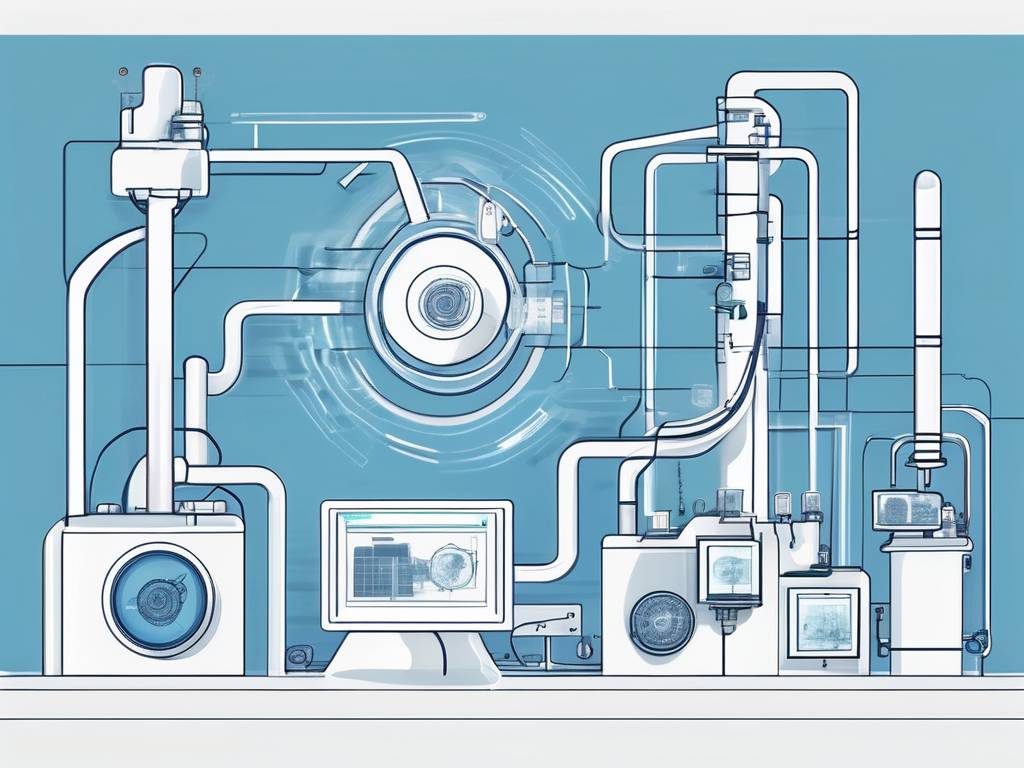IoT Predictive Maintenance: Internet Of Things Explained
The Internet of Things (IoT) is a revolutionary concept that has transformed various industries by enabling the interconnection of physical devices, vehicles, buildings, and other items embedded with sensors, software, and network connectivity. This connectivity allows these objects to collect and exchange data, thereby enhancing efficiency and enabling new services. One of the most significant applications of IoT is in the realm of predictive maintenance. This article delves into the intricacies of IoT predictive maintenance, providing a comprehensive understanding of the topic.
Predictive maintenance, as the term suggests, is a proactive maintenance strategy that involves predicting when an equipment failure might occur, and then preventing that failure through regular maintenance. IoT has significantly enhanced the capabilities of predictive maintenance by providing real-time data about the performance of equipment, which can be analyzed to predict potential failures. This article will explore the concept of IoT predictive maintenance in detail, discussing its benefits, applications, challenges, and future trends.
Understanding IoT
The Internet of Things (IoT) is a network of physical objects or “things” embedded with sensors, software, and other technologies for the purpose of connecting and exchanging data with other devices and systems over the internet. These devices range from ordinary household objects to sophisticated industrial tools. With more than 7 billion connected IoT devices today, experts are expecting this number to skyrocket to 41.6 billion by 2025.
The IoT ecosystem consists of web-enabled smart devices that use embedded systems, such as processors, sensors and communication hardware, to collect, send and act on data they acquire from their environments. IoT devices share the sensor data they collect by connecting to an IoT gateway or other edge device where data is either sent to the cloud to be analyzed or analyzed locally. Sometimes, these devices communicate with other related devices and act on the information they get from one another. The devices do most of the work without human intervention, although people can interact with the devices — for instance, to set them up, give them instructions or access the data.
Components of IoT
The IoT ecosystem is made up of several key components. First, there are the sensors that collect data from the environment. These sensors can measure everything from temperature to motion to humidity. The data collected by these sensors is then sent to IoT devices for processing.
Then there are the IoT devices themselves. These devices, which can range from simple sensors to complex industrial machines, process the data collected by the sensors and then transmit it over a network. The network, which can be a local network or the internet, is the third key component of the IoT ecosystem.
Working of IoT
The working of IoT involves a series of steps. First, the sensors collect data from the environment. This data is then processed by the IoT device, which can involve complex calculations or simple data aggregation. Once the data has been processed, it is transmitted over a network to a server or cloud platform.
Once the data has reached the server or cloud platform, it can be analyzed to extract useful information. This information can then be used to make decisions or take actions. For example, in the case of IoT predictive maintenance, the data might be used to predict when a machine is likely to fail, so that maintenance can be performed before the failure occurs.
Understanding Predictive Maintenance
Predictive maintenance is a proactive maintenance strategy that involves predicting when an equipment failure might occur, and then preventing that failure through regular maintenance. The goal of predictive maintenance is to extend the life of equipment, reduce maintenance costs, and prevent unplanned downtime.
Predictive maintenance involves the use of sensors to monitor the condition of equipment. These sensors collect data on various parameters, such as temperature, vibration, and pressure. This data is then analyzed to identify patterns or trends that might indicate a potential failure.
Benefits of Predictive Maintenance
There are several benefits to using predictive maintenance. First, it can help to extend the life of equipment by identifying potential problems before they become serious. This can result in significant cost savings, as it is often cheaper to repair or replace equipment before it fails completely.
Predictive maintenance can also help to reduce downtime. By predicting when a failure is likely to occur, maintenance can be scheduled during non-peak times, reducing the impact on productivity. Finally, predictive maintenance can improve safety by identifying potential equipment failures that could pose a risk to workers.
Challenges of Predictive Maintenance
Implementing predictive maintenance can be challenging. One of the biggest challenges is the need for advanced data analytics. Predictive maintenance relies on the ability to analyze large amounts of data and identify patterns or trends. This requires sophisticated data analytics tools and expertise.
Another challenge is the cost of implementing predictive maintenance. Installing sensors on equipment and setting up the necessary data analytics infrastructure can be expensive. However, these costs can often be offset by the savings achieved through reduced maintenance costs and extended equipment life.
IoT in Predictive Maintenance
The Internet of Things (IoT) has significantly enhanced the capabilities of predictive maintenance. IoT devices can collect and transmit data in real-time, providing a more accurate and timely picture of equipment condition. This data can then be analyzed to predict potential failures, allowing maintenance to be scheduled proactively.
IoT predictive maintenance involves the use of IoT devices to monitor the condition of equipment. These devices collect data on various parameters, such as temperature, vibration, and pressure. This data is then transmitted to a cloud platform, where it is analyzed to predict potential failures.
Benefits of IoT in Predictive Maintenance
There are several benefits to using IoT in predictive maintenance. First, IoT devices can collect and transmit data in real-time, providing a more accurate and timely picture of equipment condition. This can result in more accurate predictions, reducing the risk of unexpected equipment failures.
IoT devices can also collect data on a wide range of parameters, providing a more comprehensive picture of equipment condition. This can help to identify potential problems that might not be detected using traditional predictive maintenance techniques. Finally, IoT devices can be remotely monitored and controlled, reducing the need for manual inspections and making maintenance more efficient.
Challenges of IoT in Predictive Maintenance
One of the biggest challenges of implementing IoT in predictive maintenance is the need for advanced data analytics. IoT devices generate large amounts of data, and analyzing this data to predict potential failures requires sophisticated data analytics tools and expertise.
Another challenge is the cost of implementing IoT in predictive maintenance. IoT devices can be expensive, and there can be additional costs associated with data transmission and storage. However, these costs can often be offset by the savings achieved through improved maintenance efficiency and reduced downtime.
Applications of IoT in Predictive Maintenance
IoT predictive maintenance has a wide range of applications across various industries. In manufacturing, for example, IoT devices can be used to monitor the condition of machinery and equipment, predicting potential failures and scheduling maintenance to prevent downtime. In the energy sector, IoT devices can be used to monitor the condition of power plants and grid infrastructure, predicting potential failures and scheduling maintenance to prevent blackouts.
In the transportation sector, IoT devices can be used to monitor the condition of vehicles and infrastructure, predicting potential failures and scheduling maintenance to prevent accidents and delays. In the healthcare sector, IoT devices can be used to monitor the condition of medical equipment, predicting potential failures and scheduling maintenance to ensure patient safety.
Case Studies of IoT in Predictive Maintenance
There are several case studies that demonstrate the effectiveness of IoT in predictive maintenance. For example, a major airline used IoT devices to monitor the condition of its aircraft engines. The data collected by these devices was analyzed to predict potential failures, allowing maintenance to be scheduled proactively. This resulted in a significant reduction in downtime and maintenance costs.
Another example is a major oil and gas company that used IoT devices to monitor the condition of its drilling equipment. The data collected by these devices was analyzed to predict potential failures, allowing maintenance to be scheduled proactively. This resulted in a significant reduction in downtime and maintenance costs, as well as improved safety.
Future Trends in IoT Predictive Maintenance
The future of IoT predictive maintenance looks promising, with several trends likely to drive its growth. One of these trends is the increasing adoption of IoT devices. As more and more devices become connected, the amount of data available for predictive maintenance will increase, improving its accuracy and effectiveness.
Another trend is the increasing use of artificial intelligence (AI) in predictive maintenance. AI can be used to analyze the data collected by IoT devices, identifying patterns and trends that can be used to predict potential failures. This can result in more accurate predictions, reducing the risk of unexpected equipment failures.
Impact of 5G on IoT Predictive Maintenance
The advent of 5G technology is expected to have a significant impact on IoT predictive maintenance. 5G provides faster data transmission speeds and lower latency, which can improve the performance of IoT devices. This can result in more accurate and timely data collection, improving the accuracy of predictive maintenance.
5G can support a larger number of connected devices, increasing the amount of data available for predictive maintenance. This can result in more comprehensive monitoring of equipment condition, improving the effectiveness of predictive maintenance.
Role of AI in IoT Predictive Maintenance
Artificial Intelligence (AI) is expected to play a significant role in the future of IoT predictive maintenance. AI can be used to analyze the data collected by IoT devices, identifying patterns and trends that can be used to predict potential failures. This can result in more accurate predictions, reducing the risk of unexpected equipment failures.
AI can also be used to automate the predictive maintenance process, reducing the need for human intervention. This can make predictive maintenance more efficient, reducing costs and improving productivity.
Conclusion
IoT predictive maintenance is a powerful tool that can help to extend the life of equipment, reduce maintenance costs, and prevent unplanned downtime. By leveraging the capabilities of IoT devices and advanced data analytics, predictive maintenance can provide a more accurate and timely picture of equipment condition, enabling proactive maintenance and reducing the risk of unexpected equipment failures.
The benefits of implementing IoT predictive maintenance will be a worthwhile investment for many businesses. As the adoption of IoT devices continues to increase and technologies like 5G and AI continue to evolve, the future of IoT predictive maintenance looks promising.

 hello@westlink.com
hello@westlink.com  (866) 954-6533
(866) 954-6533  700 N Colorado Blvd,
700 N Colorado Blvd,







Comments